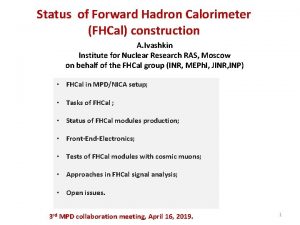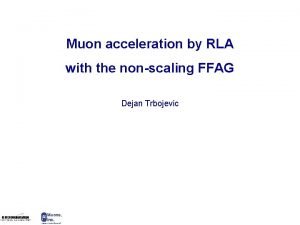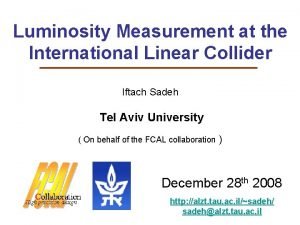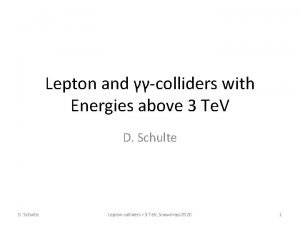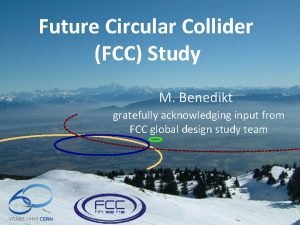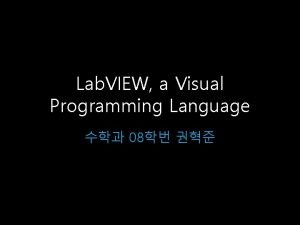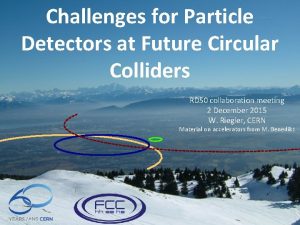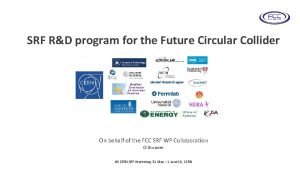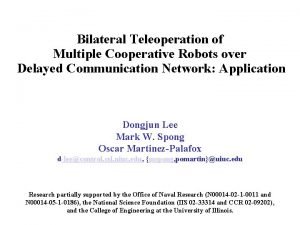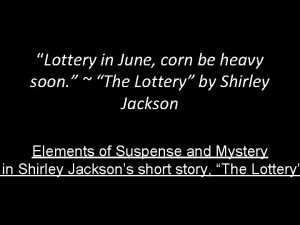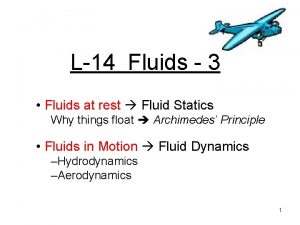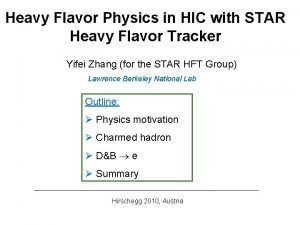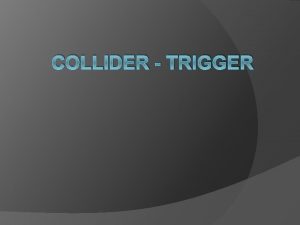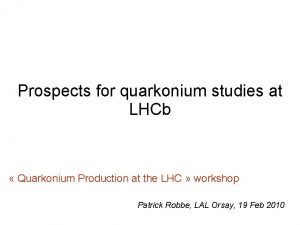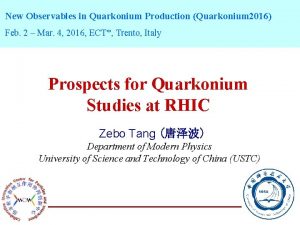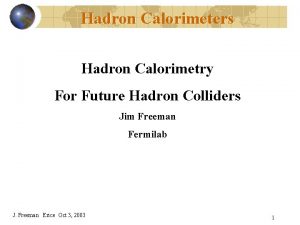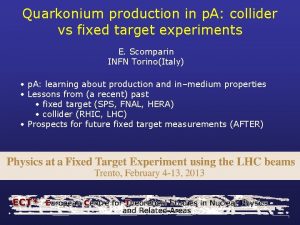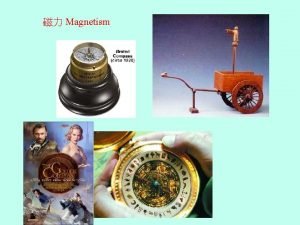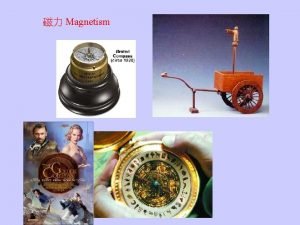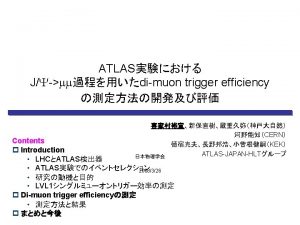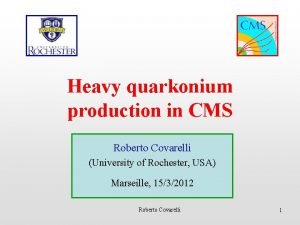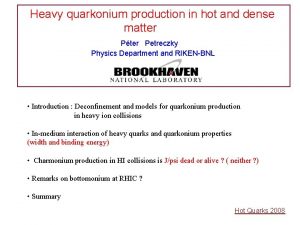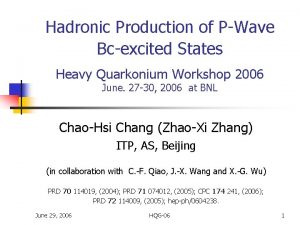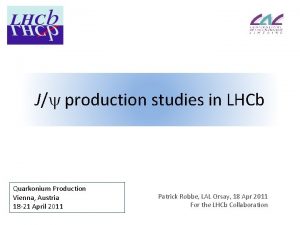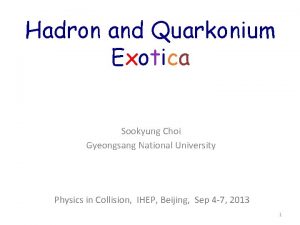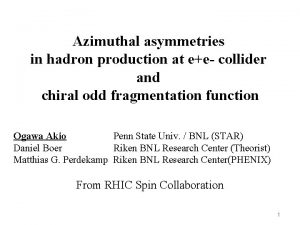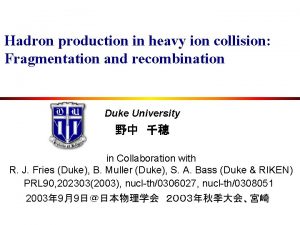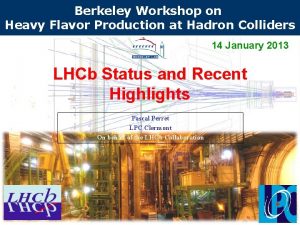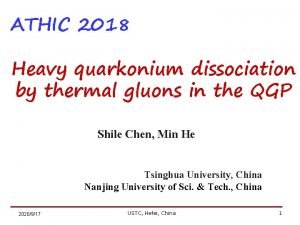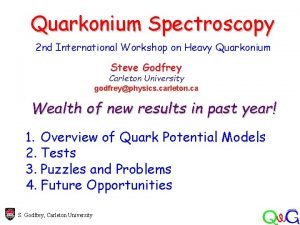HEAVY QUARKONIUM UPSILON PRODUCTION IN HADRON COLLIDER Yili























- Slides: 23

HEAVY QUARKONIUM UPSILON PRODUCTION IN HADRON COLLIDER Yili Wang Iowa State University (in collaboration with E. L. Berger and J. Qiu) Heavy Quarkonium Workshop IHEP, Beijing, China, October 12 – 15, 2004 Yili Wang – Heavy Quarkonium Workshop, IHEP Beijing Oct. 12 - 15, 2004 1

Ø Production of heavy quarks and heavy quarkonia Ø Production Models: CEM, NRQCD, … Ø CSS b-space resummation formalism Ø Upsilon production at Tevatron Ø Conclusions Yili Wang – Heavy Quarkonium Workshop, IHEP Beijing Oct. 12 - 15, 2004 2

Motivation — New Data in Tevatron QCD Perturbation Theory is very successful at high p. T New Data from Tevatron test QCD to a new level of accuracy. p. T ~ small, soft gluon radiation Need to be resumed to all orders in s Yili Wang – Heavy Quarkonium Workshop, IHEP Beijing Oct. 12 - 15, 2004 3

Factorization of Hadron Production fm PA x a. P A PB x B P b 0. 025 fm Heavy quark pairs are produced at X a distance scale much less than fm Heavy quark pairs are produced locally Yili Wang – Heavy Quarkonium Workshop, IHEP Beijing Oct. 12 - 15, 2004 4

Quarkonium production: Q a H b Q Ø Q a H b Q meson antimeson has long life time. is produced at long distance. A heavy quark pair must coherently self-interact and expand before a heavy quarkonium is formed Ø Limit on invariant mass of heavy quark pair A heavy quark pair is likely to become two open flavor heavy mesons if the invariant mass of the pair is larger than the total mass of the two mesons: Yili Wang – Heavy Quarkonium Workshop, IHEP Beijing Oct. 12 - 15, 2004 5

Production models: Different assumptions on different production models Color evaporation model (CEM) Ø All pairs with invariant mass less than open bottom threshold ( ) can become mesons. Ø Transition probability from bb pair to a meson is independent of the pair’s color and its invariant mass. ØApproximation: is a constant. Independent of color and spin Yili Wang – Heavy Quarkonium Workshop, IHEP Beijing Oct. 12 - 15, 2004 6

Non-relativistic QCD (NRQCD) model Ø All colored and uncolored pre- partonic states can become color-singlet mesons. Ø Transition probability is proportional to non-perturbative local matrix elements. Ø Quantum states [ by spin and color ] separated dependent on color and spin Yili Wang – Heavy Quarkonium Workshop, IHEP Beijing Oct. 12 - 15, 2004 7

Upsilon production at low p. T Ø Fixed-order p. T – distribution Events are dominated by low p. T region Initial-state gluon shower plays an important role Ø Resummed p. T – distribution — double logarithms Ø CSS b-space resummation Yili Wang – Heavy Quarkonium Workshop, IHEP Beijing Oct. 12 - 15, 2004 8

CSS b-space resummation formalism q Fourier transformation: q The b-space distribution: q Perturbative b-space distribution (small-b only): Yili Wang – Heavy Quarkonium Workshop, IHEP Beijing Oct. 12 - 15, 2004 9

q Sudakov exponentials: All process independent terms for A and B are known q Perturbative hard parts: The C and H depend on the resummation schemes: Lowest order partonic parts depends on production models (CEM): Yili Wang – Heavy Quarkonium Workshop, IHEP Beijing Oct. 12 - 15, 2004 10

Predictive power Ø Fourier transformation back to momentum space: b. W(b, Q) bsp bmax Ø Need nonperturbative input for b > bmax Ø Predictive power depends on the relative area for b < bmax and b > bmax Yili Wang – Heavy Quarkonium Workshop, IHEP Beijing Oct. 12 - 15, 2004 11

The b-space distribution Gluon-gluon dominates the production Gluon initiated subprocesses should lead to smaller bsp Dominated by perturbative contribution even at MΥ~10 Ge. V Better predictive power for Upsilon production! Yili Wang – Heavy Quarkonium Workshop, IHEP Beijing Oct. 12 - 15, 2004 12

Upsilon production at Tevatron CY Y(1 S) 0. 044 Y(2 S) 0. 040 Y(3 S) 0. 041 Phase space determines the relative production rate for the different S-states Yili Wang – Heavy Quarkonium Workshop, IHEP Beijing Oct. 12 - 15, 2004 13

Upsilon production at Tevatron - ll CDF Run — II Resummed Perturbative Process independent A and B only Lowest order C and H No-free parameters No dependence on C Yili Wang – Heavy Quarkonium Workshop, IHEP Beijing Oct. 12 - 15, 2004 14

Conclusions Ø At collider energies, low p. T Upsilon production is dominated by the resummable part (Sudakov logarithms) of gluon shower. Ø Our calculation predicts the right shape for the low p. T spectrum of Upsilon (no –dependence on C ). Ø calculation is also consistent with high p. T data Yili Wang – Heavy Quarkonium Workshop, IHEP Beijing Oct. 12 - 15, 2004 15

Backup transparencies Yili Wang – Heavy Quarkonium Workshop, IHEP Beijing Oct. 12 - 15, 2004 16

Matching between resum and pert Matching: Avoid pert in low p. T region. Ø at matching point: Ø resummation enhancement factor K Ø assuming K is constant Yili Wang – Heavy Quarkonium Workshop, IHEP Beijing Oct. 12 - 15, 2004 17

b-space resummation for upsilon Ø Existing calculation for colorless vector boson ( W, Z ) produced at the short distance. Ø is unlikely produced at short distance. heavy pair can carry color Ø Final-state radiation lead to Ø NRQCD factorization breaks down as p. T 0, require a non-perturbative “shape-function” Not resum the gluon radiation from the heavy quark pair Yili Wang – Heavy Quarkonium Workshop, IHEP Beijing Oct. 12 - 15, 2004 18

A new approach to the large b-region In small-b region, CSS evolution equation In large b-region, modified CSS evolution equation, including leading power corrections, Leading twist Intrinsic power corrections Dynamical power corrections g 1 and α are fixed by the continuity of W(b, Q) at bmax and have the natural √S-dependence Yili Wang – Heavy Quarkonium Workshop, IHEP Beijing Oct. 12 - 15, 2004 19

Production of heavy quark pairs o gluon fusion to heavy quarks: Dominates if 2 m. Q/√S << 0. 1 Massive production channel o light quark annihilation to heavy quarks: Dominates if 2 m. Q/√S >> 0. 1 Discovery channel Yili Wang – Heavy Quarkonium Workshop, IHEP Beijing Oct. 12 - 15, 2004 20

Both models work for S-state Ψ production as function of PT prompt ψ NRQCD CEM Our task: (n. S) — S-state expect small difference between models. Yili Wang – Heavy Quarkonium Workshop, IHEP Beijing Oct. 12 - 15, 2004 21

Location of the saddle point Ø Using saddle point method: Ø If neglecting b-dependence in , and keeping only the A(1) term in S(b, Q), at QT = 0 With λ = 16/(49 -2 nf) 0. 41 for nf = 5 Ø b-dependence in Evolution of is very steep when x is far from x 0 ~ 0. 1 Ø Since is very important Evolution of at x 0 ~ 0. 1 , saddle point depends on change sign . Yili Wang – Heavy Quarkonium Workshop, IHEP Beijing Oct. 12 - 15, 2004 22

p. T 2 p. T-double logarithms Fixed-order b-space Yili Wang – Heavy Quarkonium Workshop, IHEP Beijing Oct. 12 - 15, 2004 23
 Hadron collider
Hadron collider Hadron collider
Hadron collider Sahih so'zining ma'nosi
Sahih so'zining ma'nosi Barkamol avlod yili
Barkamol avlod yili Amortisman yılı hesaplama
Amortisman yılı hesaplama Diagram alur produksi
Diagram alur produksi Ratey algebra 2
Ratey algebra 2 Lhc tantalizing new physics
Lhc tantalizing new physics Hadron
Hadron Hadron calorimeter
Hadron calorimeter Bnl
Bnl International linear collider
International linear collider Muon collider
Muon collider Fcc collider
Fcc collider Unity sphere collider
Unity sphere collider Visual basic programming language
Visual basic programming language Fcc collider
Fcc collider Martinello colider
Martinello colider Long nose
Long nose Heavy object
Heavy object What does lottery in june corn be heavy soon
What does lottery in june corn be heavy soon Come unto me ye that are heavy laden
Come unto me ye that are heavy laden Fluids at rest
Fluids at rest Heavy flavor physics
Heavy flavor physics









